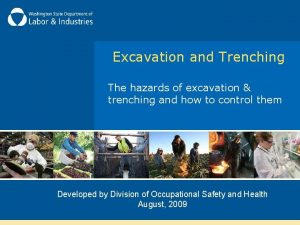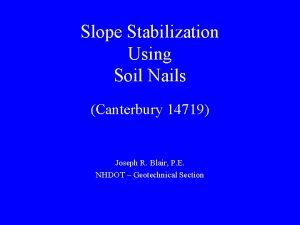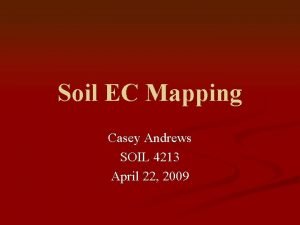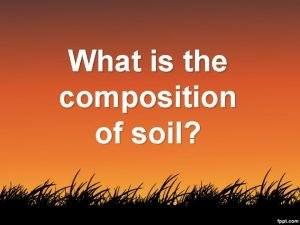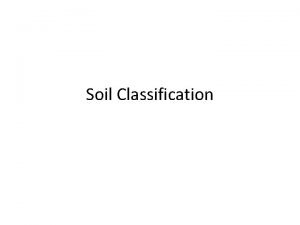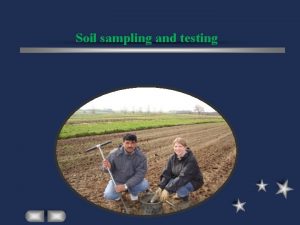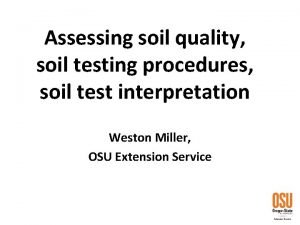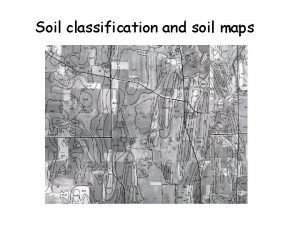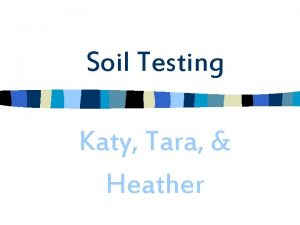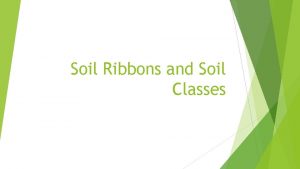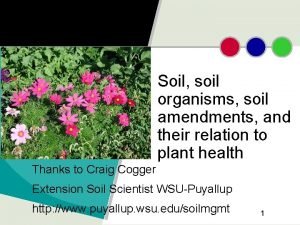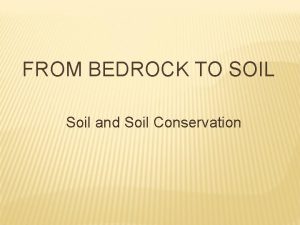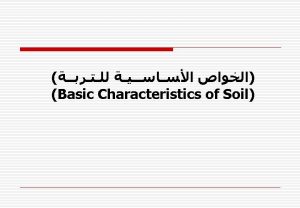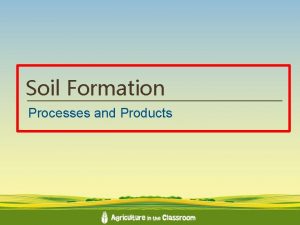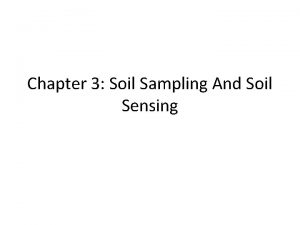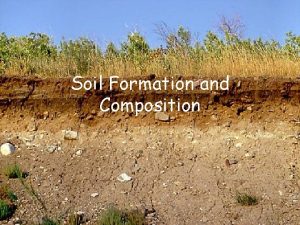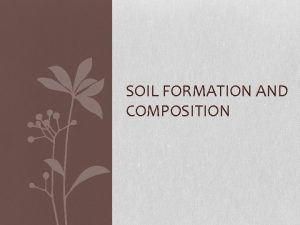Soil Types Classification and Testing Soil Classification Understanding

























- Slides: 25

Soil Types Classification and Testing

Soil Classification � Understanding what type of soil is present is important because it determines what type of plant will be most suited to an area. � This can accurately predict yields of crops for agriculture. � This can also allow for different crops to be planted that will make the most money for farmers.

Systems to Soil Classification � There are two major systems: � 1) Vernacular system � 2) Scientific system

Vernacular System � Vernacular system was developed by land users. � For example, in vernacular system soil can be categorized as red soil, black soil, yellow soil, etc. � These classifications determine what the soil can be used for. � Very general, not scientific. � Mostly based on colour and what is growing well in the soil at the time it is tested.


Scientific System � In the scientific system, the soil can be categorized according to: ◦ the development of soil (how was it created? ) ◦ the amount of substances present in the soil (what is the ratio of organic matter, water, air and minerals? )

Particle Classification � As there are various systems to classify soils, it means soil classification is not static or has 1 way of going about it. � However, most classification of soil is based on the size of the particles it contains. � This classification helps to understand the basic properties of the soil and helps to conclude if the type of soil is good enough for gardening or farming


Types of Soil � Therefore depending on the size of the particles in the soil, it can be classified into these following main types: ◦ Sandy soil ◦ Silty soil ◦ Clay soil

Sandy Soil � This soil type has the biggest particles. � This creates better aeration and drainage of the soil. � This soil is granular and consists of rock and mineral particles that are very small, creating a gritty texture. � Sandy soil is formed when rocks such as limestone, granite, quartz and shale are weathered. � Sandy soil is easier to grow on if it is rich in organic material, but can also allow for too much drainage. � This can create over-drainage and dehydration of the plants in summer.

Testing for sandy soil: � To check if soil is sandy, moisten a small sample of soil and try to make a ball using your palms. � If the soil is sandy, then no dirt balls will form and the soil will crumble and fall through the fingers.

Silty Soil � Silty soil is considered to be one of the most fertile of soils. � It can occur in nature as soil, or is often found at the bottom of lakes or rivers. � It is composed of minerals like quartz and fine organic particles. � More nutrients than sandy soil and offers better drainage. � If it is fully dry it can look like dark sand.

Testing for Silty Soil: � To check if the soil you have is silty, take a small amount of moist soil and rub it between your fingers. � If the soil is silty soil, it will feel slick and stick to your fingers.

Clay Soil � Clay is a kind of material that occurs naturally and consists of very fine grain material with less air spaces. � It is difficult to work with this soil, because the drainage in this soil is low. � Soil can become water logged and damage roots. � Very heavy when wet and lots of fertilizers need to be added. � Clay soil is formed after years of rock weathering. � Rich in mineral content.

Testing for Clay soil � To identify if the soil is clay soil, take a soil sample and damp it with water. � Rub it between your palms. � You will find clay soil is sticky and retains a good amount of water.

Types of Soil � Sandy, silty and clay soil are the 3 main types. � There are subtypes, which are not as easy to test for. � These subtypes are: ◦ Loamy soil ◦ Peaty soil ◦ Chalky soil

Loamy Soil � This soil consists of sand, silt and clay to some extent. � It is considered to be the perfect soil for gardening. � The texture is gritty and retains water very easily, yet the drainage is good. � There are various kinds of loamy soil ranging from fertile to very muddy and thick sod. � Ideal for cultivation. � Good for vegetable patches or gardens


Peaty Soil � This kind of soil is basically formed by the accumulation of dead and decayed organic matter, it naturally contains much more organic matter than most of the soils. � It is generally found in marshy areas. � Decomposition is very slow because peat is naturally acidic. This can preserve materials. � This kind of soil is formed in wet climate. � Though the soil is rich in organic matter, nutrients present are fewer in this soil type than any other type because of the slow decomposition. � Usually added to basic soil to increase water retention.


Chalky Soil Basic (alkaline) in nature, opposite to peaty soil. � Can have a large number of stones. � A lot of watering and fertilizer needed to grow plants well. � Also blocks the nutritional elements for the plants like iron and magnesium. �

p. H of soils � In this classification, soil is either acidic or alkaline soil depending on the amount of humus (completely broken down organic matter), organic matter and the underlying bedrock/parent material.

p. H Scale � All materials have a p. H level. � This determines how acidic or basic (alkaline) a material is. � If something is acidic, it will have more hydrogen (H) in it. � If something is basic, it will have more hydroxide (OH) in it.


� Most plants prefer a p. H level of 5. 8 -6. 2. � In Manitoba, our water is closer to 7. � Therefore, sometimes acids have to be added to soil to decrease the p. H to a more acidic level. � This can be done through fertilizers and solutions. � This also depends on the specific plant and the p. H of the soil itself.
 Soil classification types
Soil classification types Positive testing and negative testing
Positive testing and negative testing Static testing and dynamic testing
Static testing and dynamic testing Living soil vs dead soil
Living soil vs dead soil Living soil vs dead soil
Living soil vs dead soil Soil testing canterbury
Soil testing canterbury Brian jervis
Brian jervis Casey andrews
Casey andrews Domain testing in software testing
Domain testing in software testing Kv charts in software testing
Kv charts in software testing Du path testing
Du path testing Globalization testing in software testing
Globalization testing in software testing Functional testing vs unit testing
Functional testing vs unit testing Cause effect graph for triangle problem
Cause effect graph for triangle problem Control structure testing in software engineering
Control structure testing in software engineering Decision table testing in software testing
Decision table testing in software testing Decision table based testing
Decision table based testing Black-box testing disebut juga sebagai behavioral testing
Black-box testing disebut juga sebagai behavioral testing Behavioral testing adalah
Behavioral testing adalah Decision tables testing
Decision tables testing Rigorous testing in software testing
Rigorous testing in software testing Testing blindness in software testing
Testing blindness in software testing Component testing is a black box testing
Component testing is a black box testing Domain testing example
Domain testing example What's the
What's the Layers of soil for grade 4
Layers of soil for grade 4
